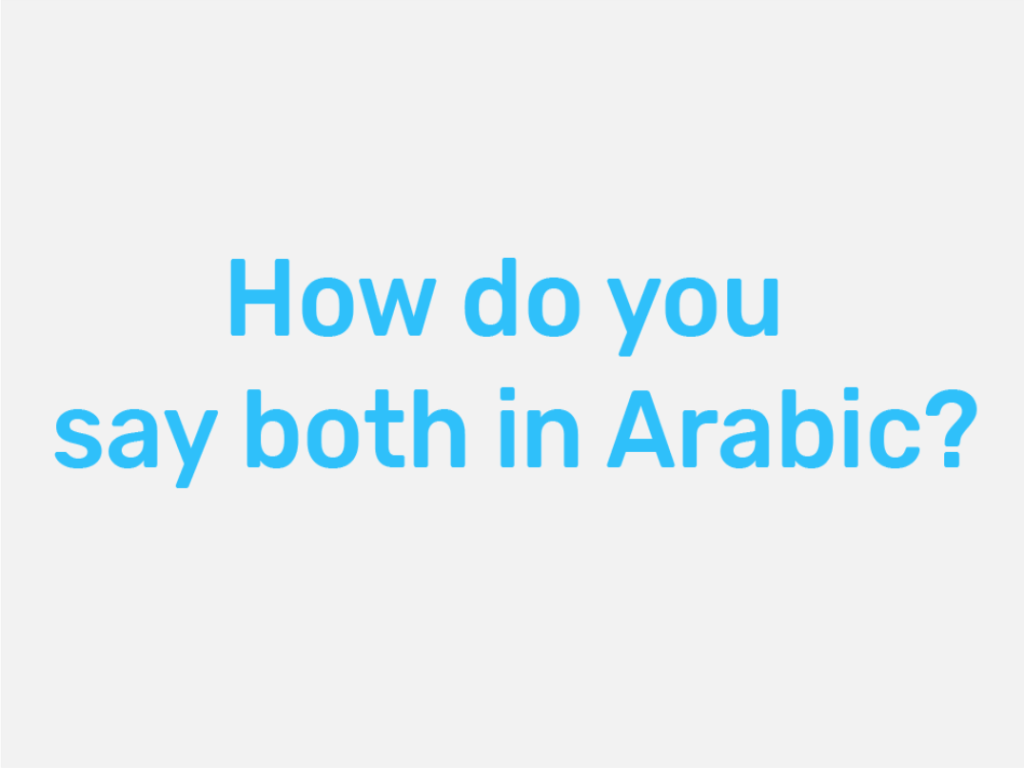Have you ever wondered how to say both in Arabic? This little word is incredibly useful, but it can be a bit tricky because Arabic uses different words depending on whether you’re talking about two people or two things. Don’t worry, it’s easier than you think! In this guide, we’ll break down the meaning and usage of both of them in Arabic so you can use it confidently.
Basic Forms of “Both”
The main word you’ll need is كِلا (kilā) or كِلْتَا (kiltā). The word you choose depends on the gender of the two things you’re talking about.
- (kilaa) کِلا is for two masculine nouns.
- (kiltaa) كِلْتَا is for two feminine nouns.
It’s similar to how some other words in Arabic change based on gender, like هَذَا (HaTHaa) and هَذِهِ (haaTHihi) for “this.”
Using “Both” with Nouns
When you want to say “both” followed by a noun, you need to use the word with the correct gender. The word you use will have an alif al-maqsura (ى) at the end. Here are some examples:
- Both boys: كِلَا الوَلَدَينِ (kilaa al-waladayn)
- Both girls: كِلْتَا البِنْتَينِ (kiltaa al-bintayn)
- Both books: كِلَا الكِتَابَينِ (kilaa al-kitābayn)
- Both cars: كِلْتَا السَّيَّارَتَينِ (kiltaa al-sayyāratayn)
Notice that the noun after كِلَا or كِلْتَا is always in the dual form and takes the kasra (ــِ) sound at the end.
How to Say “Both of Them” in Arabic
Often, you don’t want to say “both” followed by a noun, but rather “both of them.” This is where you use the pronoun endings. You attach a pronoun to the end of كِلَا or كِلْتَا, and the last letter changes from an alif al-maqsura (ى) to a regular alif (ا).
Here are the forms for “both of them”:
- For two masculine objects: كِلَاهُمَا – kilaahumaa
- Example: I saw them both (masculine)- رَأَيْتُ كِلَاهُمَا – ra’aytu kilaahumaa
- For two feminine objects: كِلْتَاهُمَا – kiltaahumaa
- Example: I saw them both (feminine) – رَأَيْتُ كِلْتَاهُمَا – ra’aytu kiltaahumaa
Both meaning in Arabic is about more than just one word; it’s about making sure the word you use matches the gender and number of the people or things you’re talking about.
| Arabic Word | English Meaning | Gender | Usage |
|---|---|---|---|
| كِلا – kilaa | Both | Masculine | Used before a dual noun. |
| كِلْتَا – kiltaa | Both | Feminine | Used before a dual noun. |
| كِلَاهُمَا – kilaahumaa | Both of them | Masculine | Used with a dual masculine pronoun. |
| كِلْتَاهُمَا – kiltaahumaa | Both of them | Feminine | Used with a dual feminine pronoun. |
Examples in Sentences
To help you understand how to say both in Arabic in real-life situations, here are a few more examples:
- كِلَا الطَّالِبَينِ ذَهَبَا إِلَى المَكْتَبَةِ.
- Both students went to the library. (talking about two male students)
- (kilaa alTTaalibayni THahabaa ʼilaa almaktabah.)
- قَرَأْتُ كِلْتَا الصَّفْحَتَينِ.
- I read both pages. (talking about two pages, which are feminine in Arabic)
- (qaraʼtu kiltaa alSSafHatayn.)
- هَذَانِ المُعَلِّمَانِ جَيِّدَانِ. أُحِبُّ كِلَيهِمَا.
- These two teachers are good. I like both of them. (talking about two male teachers)
- (haaTHaani almuʻallimaani jayyidaani. ʼuHibbu kilayhimaa.)
- نَجَحَتْ كِلْتَا الأُخْتَينِ فِي الاِمتِحَانِ.
- Both sisters passed the exam.
- (najaHat kiltaa alukhtayn fee alimtiHaani.)
As you can see, once you understand the simple rules of gender and number, using both in Arabic becomes quite straightforward.
Conclusion
Mastering the word both in Arabic is a great step forward in your language journey. It’s a key part of speaking more naturally and precisely. Remember the simple rule: كِلا for masculine and كِلْتَا for feminine, and add the pronoun هُمَا to say both of them. Keep practicing these words, and soon they’ll become second nature!
For more helpful Arabic lessons and to learn to speak Arabic fluently, check out our other articles. Better yet, why not download the Kaleela Arabic learning app and learn to speak Arabic today?



